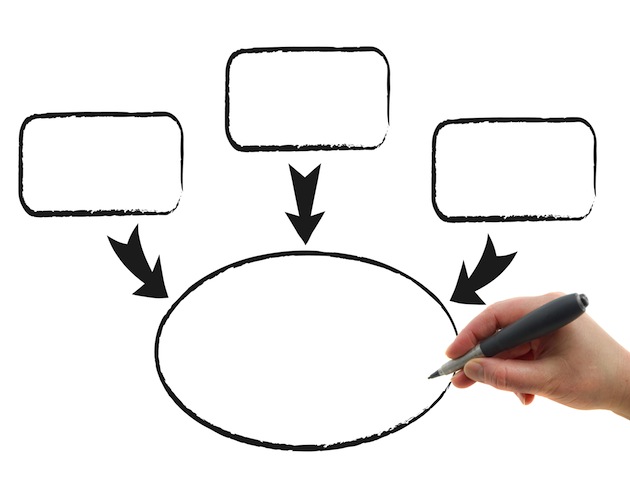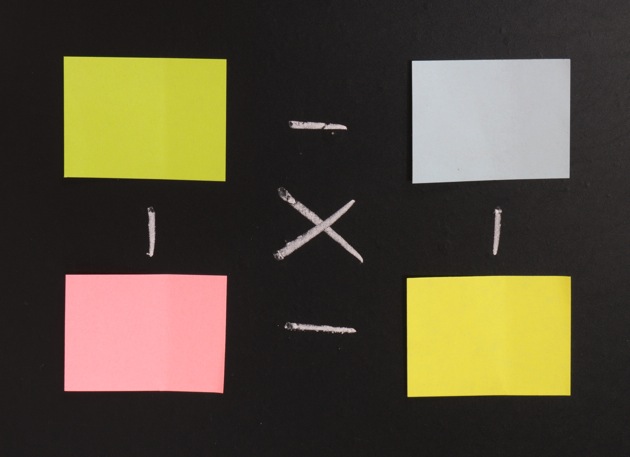The value of bringing people with different perspectives together to work a problem is readily accepted by most. The business of making websites, software and other technical systems is too complex for an individual to execute in isolation. No surprise, then, that collaboration sessions are a standard process at any company concerned with building our digital world.
Powerful ideas are sparked when people of one focus are exposed to an unfamiliar subject. Jonah Leher recounts many stories of brilliance achieved out of unlikely, spontaneous collaborations in his article “Groupthink.” He also points out that attempting this kind of collaboration in a forced meeting can be much less fruitful. For example, the technique of brainstorming, while frequently used, actually generates fewer ideas than several people working independently.
A term first coined by Irving Janus, groupthink is the condition caused by social forces that causes contributors to focus on homogenous ideas and even unconsciously agree with faulty thinking. In order to collaborate effectively in a group setting we need to develop techniques to avoid this issue. If we look to high-preforming co-located teams for inspiration, their environment facilitates collaboration when appropriate rather than at some artificially selected time.
Can we harness that power in a more predictable fashion so that we don’t have to wait around for lightning to strike? The answer is yes, but it takes a little preparation and work.
Cramped Collaboration
Look at your average collaboration session. Several people from different disciplines attend a meeting that starts off with a short briefing of the problem. There’s usually very little context, no facilitation, and no mention of what will happen with the ideas that are shared. Then the participants are expected to start thinking up ideas on the spot. Typically, no one has had time to contemplate the problem, gather any insights, or discuss the implications of any solutions they may propose. It’s about the least productive set up that you can give a team. Yet we do it all the time.
When someone says, “Let’s get the right people in a room and we can solve this thing.” They tend to be looking for a shortcut to solve a problem. Having people working together does cut down on time spent having discussions over email or worse, losing time because one person spun their wheels on a solution only to have another person point out why it isn’t viable later. But, it doesn’t replace the time needed for individual contemplation.
Time to Think
You can help provide the team with that time by giving them with some information ahead of time. First, don’t send out a cryptic meeting invitation. You’ll get more people to show up if they know what the meeting is about, so provide as much information about the situation as you can before the work session.
Try providing the brief in advance, or executing the briefing portion of the festivities separately from the scheduled collaboration session. Even if it’s sent in an email without context, you’ve introduced the topic and given the seeds of ideas a chance to germinate. Use a social collaboration space that will allow the team to probe for more detail and share information without requiring everyone to be together at the same time. This takes a little more effort on the part of the organizer, but what you get back will more than make up for it.
Set Expectations
Show respect for all of the other things jockeying for the team’s time and attention by giving them a frame of reference. A well-intentioned developer may be reluctant to propose something labor intensive if people are already stretched too thin. Let everyone know if they are committing to a larger effort or just brainstorming.
While you’re setting expectations, do the work of setting a specific goal for the session. The team will [reach this goal] by [this time] in order to [create this future impact]. This is the anchor that will keep the discussion from drifting off course. This kind of statement will also help identify the immediate needs as well as those issues that can be deferred.
Acknowledge Communication Challenges
If you’re fortunate enough to have a group assembled from an assortment of roles, you’ve got another challenge: communication. We don’t all speak the same language. The more diversity there is, the more effort it will take for us to understand and synthesize what everyone is saying. Acknowledge this disparity and make sure everyone understands one another before judging ideas. Only then you will harness the power of bringing these different vantage points together and reach that sweet spot where you start riffing off ideas.
User experience pros are well suited to facilitating in these situations. During user research, we practice techniques which ensure that we gather accurate meaning from participants’ statements while tailoring our communication style to match our audience. Our role also requires a basic understanding of multiple disciplines. Our talents for generating empathy for users is put to good use generating empathy amongst team members in a meeting situation.
Don’t be All Talk
Many meetings become a rush for each person to get their ideas heard before the buzzer. However, we can’t feed off the perspectives of others and combine them with our own ideas if we don’t hear them. A facilitator needs to set the pace of discussion, slow down the chatter, and let everyone listen to what everyone else is saying.
Also, allow people nonverbal tools to get their ideas and questions on the table. This takes the pressure off the discourse and provides folks breathing room. Give your group sticky notes to put ideas, questions, or assumptions on the board. It’s less awkward than raising your hand. Good listening seems so basic that it shouldn’t need extra attention from the facilitator. However, the intensity of conversation, the desire to make a contribution, and the need to be heard can make mature adults behave like the Interrupting Chicken.
Not only do people speak differently, we also require different ways to process information. Some people need time alone to think before contributing. These people are often given short shrift in group situations and we all miss out on their contribution. See Susan Cain’s book, Quiet: The Power of Introverts in a World that Can’t Stop Talking, for more on getting value from the quieter set. You may also have team members who are more effective thinking out loud with someone to bounce their ideas off. Get the most out of everyone by building time into the schedule for the group to break into small groups or work alone and then come back together. When everyone comes back you are likely to get more ideas than if everyone had stayed together in the same room.
Make Conflict Constructive
Not many of us are taught to treat moments of disagreement as opportunity. The friction created by creative conflict can be used as fuel to arrive at more nuanced and effective ideas. Turning conflict into positive energy requires more than compromise, however. It takes a willingness to open your mind to something you disagree with in order to find the nugget of brilliance that you can embrace. The next time someone presents an idea that you don’t agree with, instead of gracefully explaining why they are wrong try: “I’m not crazy about the concept, but let’s dig into it further to see if there is something there that I’m missing.”
Improvisation coaches teach the “yes, and…” exercise. Your partner starts acting out a scene, and you have to jump in and respond with “yes, and…” to whatever they are doing. For example, your counterpart is pantomiming washing a car and says “This car is so filthy.” You respond with, “Yes, and next time we should stay on the road instead of driving into a ditch.” You have to accept and build upon whatever your partner has done. It’s about extracting value from your partner’s idea, supporting each other, and building trust. It’s a great method to try out when brainstorming with a group. See how far you can take a concept before judging or discarding it.
Here’s how to set it up. Have everyone write an idea on paper. Once all are submitted, select one from the pile. Then take turns with each member of the group expanding on the idea, or adding detail. In a multidisciplinary team, you can discuss how each specialized area would execute the concept or the additional opportunities within the concept.
For instance, a marketing strategist presents an idea for using QR codes as part of a product promotion. The developer may think QR codes are the wrong idea, but he contributes that using the data from the QR code in combination with a phone’s GPS capability is an opportunity to let the consumer know where they can get the best price on a product nearby. Keep going around the table with each person building on the concept until the well is dry. Then pick the next idea from the pile. This technique will force you to stretch your mind while providing the constructs to break out of group think.
Conclusion
While it has been proven that brainstorming is ineffective and groupthink is a considerable barrier to fruitful collaboration, there are benefits to getting diverse minds together and focusing on a shared effort. The friction of one idea against another gets individuals to explore directions they have not previously considered—expanding creativity.
In order to do this, we need to stop thinking that collaboration is something that just happens on its own. Overcoming the tendencies that prevent groups from being productive requires proactive organization and some effort. A designated facilitator can guide the group and assist them with methods that better channel group dynamics in productive directions.
All that’s truly required is for your group to agree to break free from the trappings of traditional brainstorming and try techniques that play to the strengths of group behavior. It may take some practice but your team will look forward to those work sessions instead of rolling their eyes at the invitation.
Images of bored meetings attendees, thinking man, bubble illustration, conflict, and paper pass courtesy Shutterstock.








